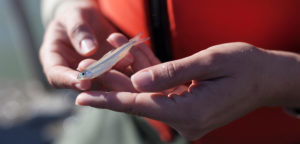A funny thing happened in 2000. And again in 2003. For the first and second time in recorded history, a southern resident killer whale entered the waters of Monterey Bay. With fewer than 80 remaining individuals, the southern resident orcas are more commonly spotted in Puget Sound and off southern Vancouver Island. The whales have suffered a number of hardships over the past several decades: an increase in water pollution and vessel traffic and a decrease in chinook salmon, their staple food. According to the Oakland office of the Center for Biological Diversity (CBD), the southern residents, which have a unique acoustic repertoire and don’t interbreed with other killer whale populations, could become extinct in as little as 30 to 100 years. Some experts suggest the whales swam as far south as Monterey in search of new food sources due to the depletion of food stocks in their home waters; others believe migration records may be incomplete, and that perhaps coastal California waters are part of the southern residents’ traditional range. Either way, the CBD is hoping the whales will be around long enough to sort the situation out. In May of 2001, the CBD and other groups filed a petition with the National Marine Fisheries Service (NMFS) to add the southern residents to the endangered species list, thereby giving the population full protection under the federal Endangered Species Act. In an unprecedented finding, the NMFS declared in July 2002 that the southern resident stock is too “insignificant” to be included on the federal list, invoking a new rationale for declining to protect a species. Says Brent Plater of the CBD, “This is the first time I’m aware of any administration stating that a population won’t be protected because we don’t find that population to be significant.” The CBD and its partners filed a lawsuit against NMFS last December protesting the decision; oral arguments are expected to begin in August or September.
.jpg)
Wildlife




